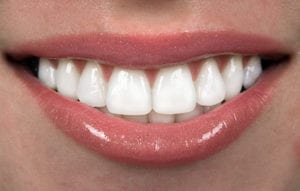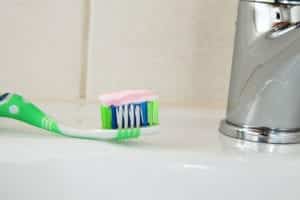
Beautiful, white teeth can take years off your appearance and make you feel more comfortable and confident! So how can you get the pearly whites you deserve without feeling the discomfort from overly sensitive teeth? Let’s take a look at why teeth get sensitive and tips to get you looking great while feeling just fine!
Tooth Sensitivity and Whitening
While the exterior of each tooth is hard, the inside of a tooth is made up of a softer layer called dentin. This dentin has nerves and, when exposed, can cause tooth sensitivity. When you go through a teeth whitening process, whether professionally done at our office or using a whitening kit at home, the whitening gel or solution can temporarily expose the dentin and make it feel sensitive or uncomfortable.
Because virtually all of our patients have been amazed how great their teeth look after teeth whitening, we wanted to share ways to avoid any discomfort so you, too, can enjoy a dazzling smile!
Before Whitening
 For about two weeks ahead of starting your teeth-whitening sessions, brush your teeth with desensitizing toothpaste. Desensitizing toothpaste is safe and contains potassium nitrate that will help block pain to the nerves in the teeth. Another option is to use a desensitizing gel or paste (like used on babies when they are teething), rubbing it directly onto your teeth.
For about two weeks ahead of starting your teeth-whitening sessions, brush your teeth with desensitizing toothpaste. Desensitizing toothpaste is safe and contains potassium nitrate that will help block pain to the nerves in the teeth. Another option is to use a desensitizing gel or paste (like used on babies when they are teething), rubbing it directly onto your teeth.
You should also look after your gums to avoid increased sensitivity. Vitamin E oil is a good solution as it will protect the gums from irritation. Just gently dab it along the gum line (but not on the teeth) if you are using whitening trays. Also, if you’re whitening at home, avoid using too much whitening gel. Just a small amount is needed to cover the front of the teeth – if the gel oozes out when you put in a whitening tray, you’re using too much!
If sensitivity is a real problem, consider taking an anti-inflammatory painkiller, like ibuprofen, a half hour before your whitening session.
During Whitening
Professional whitening sessions at our office will use the exact amount of whitening gel or formula, for the precise amount of time, and with custom-fitted trays for you to achieve an attractive, white smile in the quickest amount of time! If you suffer from teeth pain, talk to us about lowering the concentration of peroxide in the whitening gel as we have options that will help avoid any discomfort.
If you’re whitening at home, the key is to use only the recommended amount of whitening gel, for the prescribed amount of time, and at the same time each day. You won’t receive quicker results using more gel, but you could cause teeth or gum discomfort. Another tip is to give your teeth a break between treatments to help them recover; this won’t stop your progress but can offer relief for your teeth as you go through the whitening process.
After Whitening
Whether you’re having professional whitening treatments at our office or doing it yourself at home, avoid hot or cold food or drinks, acidic foods, and carbonated drinks right after treatment. When you brush your teeth, use a soft bristled toothbrush that will be gentle on your whitened enamel and rinse with lukewarm water. Fluoride toothpaste can help close the pores to the dentin or continue with your toothpaste for sensitive teeth to get the maximum protection.
To keep your new smile protected, also avoid staining liquids like coffee, tea, red wine, sports drinks, or dark sodas. If you need a cup in the morning to get going, use a straw to avoid it getting on your new, pearly whites!
Interested in teeth whitening? We’d be glad to talk with you about options that are best for your teeth. Please contact us and we’ll get you on the road to an even more beautiful smile!
